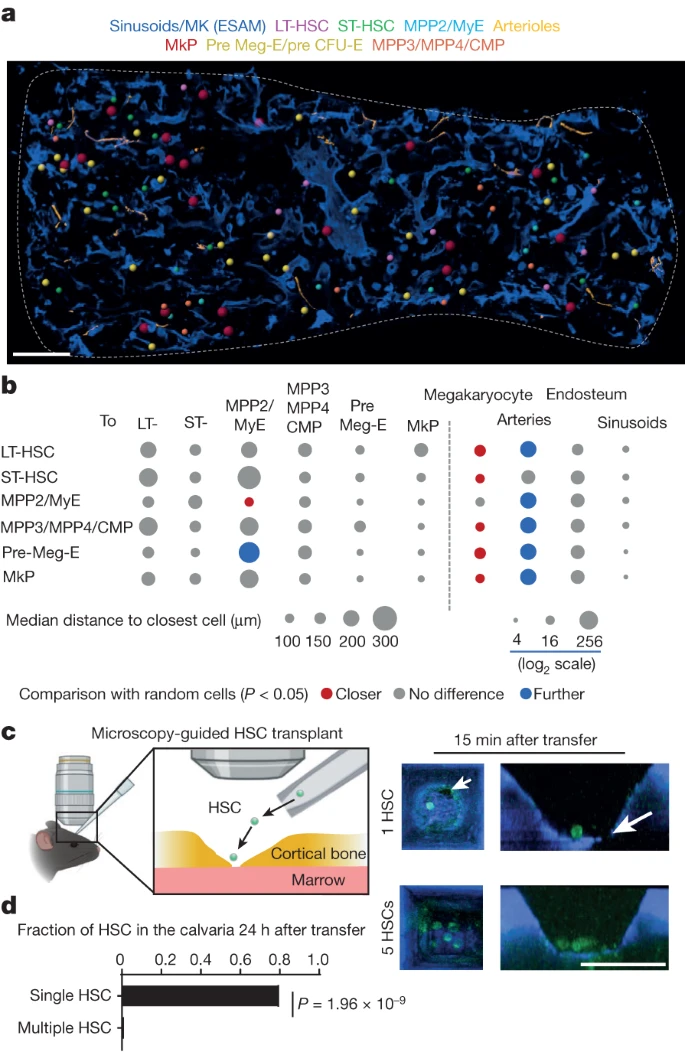Unlocking the Mysteries of Blood-Cell Production in Bone Marrow Through Advanced Microscopy
In a groundbreaking discovery, researchers have unveiled a powerful new microscopy technique that sheds light on the intricacies of blood-cell production in the bone marrow of mice. The study, published in Nature by Wu et al., showcases a method for imaging the production of various blood cell types in the bones, revealing a detailed organization of cell lineages in response to stressors like bleeding and infection.
Blood cells are constantly regenerated through a process known as haematopoiesis, occurring primarily in the bone marrow of adult mammals. This dynamic process allows the body to adapt to various challenges, such as infections, by producing different types of blood cells. Wu and colleagues have developed a cutting-edge protocol that enables visualization of the most immature haematopoietic stem and progenitor cells, red blood cell production, and the generation of immune cells like dendritic cells and B lymphocytes within the bone marrow.
By leveraging a combination of fluorescence microscopy and specific surface markers on bone marrow cells, the researchers uncovered the spatial organization of stem cells and different progenitor cells relative to each other and other anatomical structures within the bone marrow. They observed that blood-cell production sites are distinct and non-overlapping, with specific cell populations clustered around small blood vessels. Stem cells were found as solitary entities, while lineage-committed progenitors formed clusters with their daughter cells, showcasing a defined architectural pattern in the bone marrow.
Furthermore, the study demonstrated that blood-cell production sites are flexible and can adjust their output in response to external stressors, returning to baseline once the stress is resolved. Interestingly, different bones within the skeleton exhibited varying responses to stress, highlighting the intricate regulation of blood-cell production throughout the body.
While this innovative microscopy technique provides unprecedented insight into bone marrow anatomy and haematopoiesis, the widespread application of this technology may face challenges due to the complex requirements of fluorescently labeled antibodies and advanced imaging equipment. Future research directions may involve enhancing image analysis software and integrating molecular profiling methods to deepen our understanding of disease progression and immune responses within the bone marrow.
This groundbreaking discovery opens up new avenues for studying blood-cell production dynamics and its role in health and disease, offering a fresh perspective on the biological complexities of the bone marrow environment.
Blood cells are constantly regenerated through a process known as haematopoiesis, occurring primarily in the bone marrow of adult mammals. This dynamic process allows the body to adapt to various challenges, such as infections, by producing different types of blood cells. Wu and colleagues have developed a cutting-edge protocol that enables visualization of the most immature haematopoietic stem and progenitor cells, red blood cell production, and the generation of immune cells like dendritic cells and B lymphocytes within the bone marrow.
By leveraging a combination of fluorescence microscopy and specific surface markers on bone marrow cells, the researchers uncovered the spatial organization of stem cells and different progenitor cells relative to each other and other anatomical structures within the bone marrow. They observed that blood-cell production sites are distinct and non-overlapping, with specific cell populations clustered around small blood vessels. Stem cells were found as solitary entities, while lineage-committed progenitors formed clusters with their daughter cells, showcasing a defined architectural pattern in the bone marrow.
Furthermore, the study demonstrated that blood-cell production sites are flexible and can adjust their output in response to external stressors, returning to baseline once the stress is resolved. Interestingly, different bones within the skeleton exhibited varying responses to stress, highlighting the intricate regulation of blood-cell production throughout the body.
While this innovative microscopy technique provides unprecedented insight into bone marrow anatomy and haematopoiesis, the widespread application of this technology may face challenges due to the complex requirements of fluorescently labeled antibodies and advanced imaging equipment. Future research directions may involve enhancing image analysis software and integrating molecular profiling methods to deepen our understanding of disease progression and immune responses within the bone marrow.
This groundbreaking discovery opens up new avenues for studying blood-cell production dynamics and its role in health and disease, offering a fresh perspective on the biological complexities of the bone marrow environment.



Comments
Post a Comment